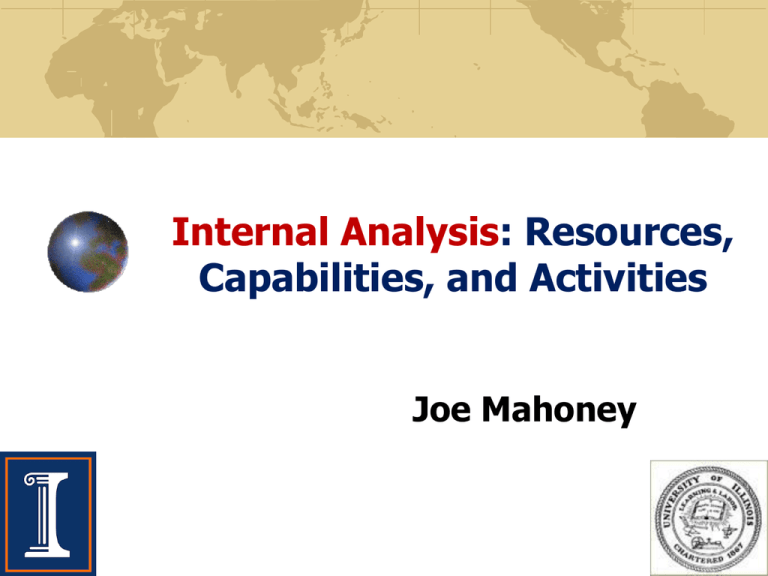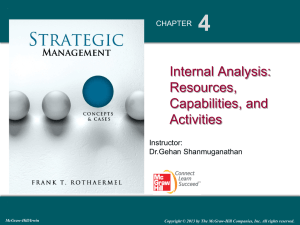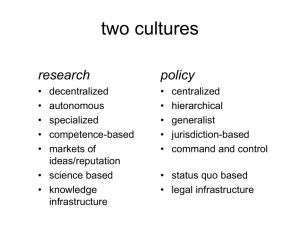4 Internal Analysis: Resources, Capabilities, and Activities
advertisement

Internal Analysis: Resources, Capabilities, and Activities Joe Mahoney Internal Analysis: Inside the Firm • Comparing two firms in same industry: Internal focus Core Competencies Unique Can strengths deep inside that differentiate a firm drive competitive advantage Strategic Fit Internal strengths fit with the environment external Creating Strategic Fit to Leverage Internal Strengths 4–3 The Role of Strategy in Business is to Generate and Sustain Value via the Linkages Between Positioning, Organization, and Resources & Capabilities Positioning Organization Resources & Capabilities 4–4 Positioning • Scope of the Firm: Geographic scope Product-market scope: Choice of businesses (corporate portfolio analysis) Product market positioning within a business Vertical integration (value chain) decisions Organization • Structure Formal definition of authority Conflict resolution • Systems Rules, routines, evaluation and rewards • Processes Informal communication, networks, and recruitment 4-6 Resources and Capabilities • Tangible resources e.g., physical capital • Organizational capabilities e.g., routines and standard operating procedures • Intangible resources e.g., trademarks, “know-how” 4–8 Linking Resources and Capabilities to Firm Performance Company Examples of Core Competencies and Applications 4–11 Tangible and Intangible Resources 4–12 The Resource-based View • Google Example Tangible resources valued at $5 billion Intangible brand valued at over $100 billion Googleplex has both tangible and intangible aspects • Competitive Advantage More Likely….. From intangible resources 4–14 Two Critical Resource Dimensions in RBV • Resource heterogeneity Bundles of resources and capabilities differ across firms Southwest Airlines and Alaska Airlines have different resources SWA – Higher employee productivity – Informal organization, pilots help load luggage • Resource immobility Resources tend to be “sticky” and do not move easily Southwest Airlines sustained advantage Several decades superior performance Competitors have unsuccessfully imitated SWA model 4–15 Applying RBV: Decision Tree Competitive Implications The Value Chain • Primary Activities Add value directly in transforming inputs into outputs Raw materials through production to customers • Support Activities Indirectly add value Provide support to the primary activities Information systems, human resources, accounting, etc. • Managers can see how competitive advantage flows from a system of activities (using activity-based accounting). 4–18 Value Chain: Primary and Support Activities Hostess’s Cost Components 80 Profit 70 Marketing: Promotions Cents per unit 60 Marketing: Advertising 50 Outbound logistics 40 Operations: Manufacturing 30 Operations: Packaging 20 Operations: Ingredients 10 0 © 1999 Pankaj Ghemawat Relative Cost Analysis 90 80 Profit 70 Marketing: Promotions Cents per unit 60 Marketing: Advertising 50 Outbound logistics 40 Operations: Manufacturing 30 20 Operations: Packaging 10 Operations: Ingredients 0 Hostess © 1999 Pankaj Ghemawat Little Debbie Ontario Baking Savory Pastries Value Chain Analysis • Outsourcing activities can have the unintended consequence of damaging the firm’s potential to evaluate continuously its key assumptions, learn, and create new capabilities and core competencies. Thus, managers should verify that the firm does not outsource activities that stimulate the development of new capabilities and competencies. 4–22 Strategic Coherence The Logic of How The Business Fits Together: • Southwest Airlines Low Price Short Routes • No Frills • Point-to-Point • One Aircraft -Boeing 737 • High number of Aircraft per Route • No Meals • Flexible/ Lower Staffing • American Airlines Premium Price Short, Long, & Int’l Variety • Hub & Spoke System • Multiple Aircraft • Low number of Aircraft per Route • Meals & Service • Higher Staffing Southwest Airline’s Activity System No baggage transfers No meals No seat assignments Frequent, reliable departures High compensation of employees Flexible union contracts 15-minute gate turnarounds Lean, highly productive ground and gate crews High level of employee stock ownership Limited passenger amenities Limited use of travel agents No connections with other airlines Standardized fleet of 737 aircraft Short-haul, point-to-point routes between midsize cities and secondary airports Automatic ticketing machines Very low ticket prices High aircraft utilization “Southwest, the low-fare airline” 24 Strategic Coherence: Fit and Balance • A fit among corporate, business, and functional strategy; • A fit between strategy formulation and implementation; • A balance of commitment and flexibility; • A balance among stakeholders; • A balance of competition and cooperation; • A balance of hiding and diffusing information; • A balance of centralization and decentralization; and • A balance between stability and change. 4–25 Strategic Coherence • Combining activities that complement and reinforce one another. These activities dovetail together to help achieve the overall objectives of the firm. • Such strategies, which may regarded as systems of activities are often more successful because they are more difficult to imitation. Thus, they can lead to a sustainable competitive advantage. • Strategic coherence may not be a sufficient condition for attaining a competitive advantage, but it is often a necessary one. 4–26 Strategic Coherence • A sustainable competitive advantage often requires tradeoffs. These tradeoffs arise for at least three reasons: Inconsistencies in image or reputation. Tradeoffs arising from the activities themselves. Limits on internal coordination and control • General management at its core is strategy: Defining and communicating the company’s unique position; Making tradeoffs; Forging a dynamic fit among activities (i.e., strategic coherence). 4–27 Dynamic Strategic Activity Systems • A network of interconnected activities in the firm • Evolve over time – external environment changes Add new activities & upgrade or remove obsolete ones • Vanguard Example A global investment firm - $1.4 trillion managed assets Emphasis on low customer cost and quality service – Among the lowest expense ratios in the industry (0.20%) Updated the activity system from 1997 to 2011 New customer segmentation core Two new support activities Permits customized offerings: long-term and more active traders 4–28 Vanguard Group’s Activity System 1997 Legend Core Support 4–29 Vanguard Group’s Activity System 2011 Legend Core Support 4–30 Dynamic Capabilities Perspective • A firm can modify its resource base to gain & sustain a competitive advantage Advantage is gained from reconfiguring a firm’s resource base Honda core competency in gas-powered engine design Could If decrease in value consumers move toward electric-powered cars BYD competency in batteries would gain advantage • Dynamic capabilities are an intangible resource • Resource stocks and flows are a useful view 4–31 Role of Inflows and Outflows in Building Stocks 4–32 IBM Product Scope 1993 and 2010 In 1993, hardware accounted for 50% of IBM revenues In 2010, software & (IT) services accounted for 80% of IBM revenues, hardware was down to 18% 4–33 How to Protect a Competitive Advantage 1. Better Expectations of Future Values Buy Resources at a low cost Real Estate Development - highway expansion 2. Path Dependence Current alternatives are limited by past decisions Honda’s core competency in gas engines took decades to build 4–34 How to Protect a Competitive Advantage 3. Causal Ambiguity Cause of success or failure are not apparent Why has Apple had such a string of successful products? – Role of Steve Jobs’ vision? – Unique talents of the Apple design team? – Timing of product introductions? 4. Social Complexity Two or more systems interact creating many possibilities A group of 3 people has 3 relationships A group of 5 people has 12 relationships 4–36




